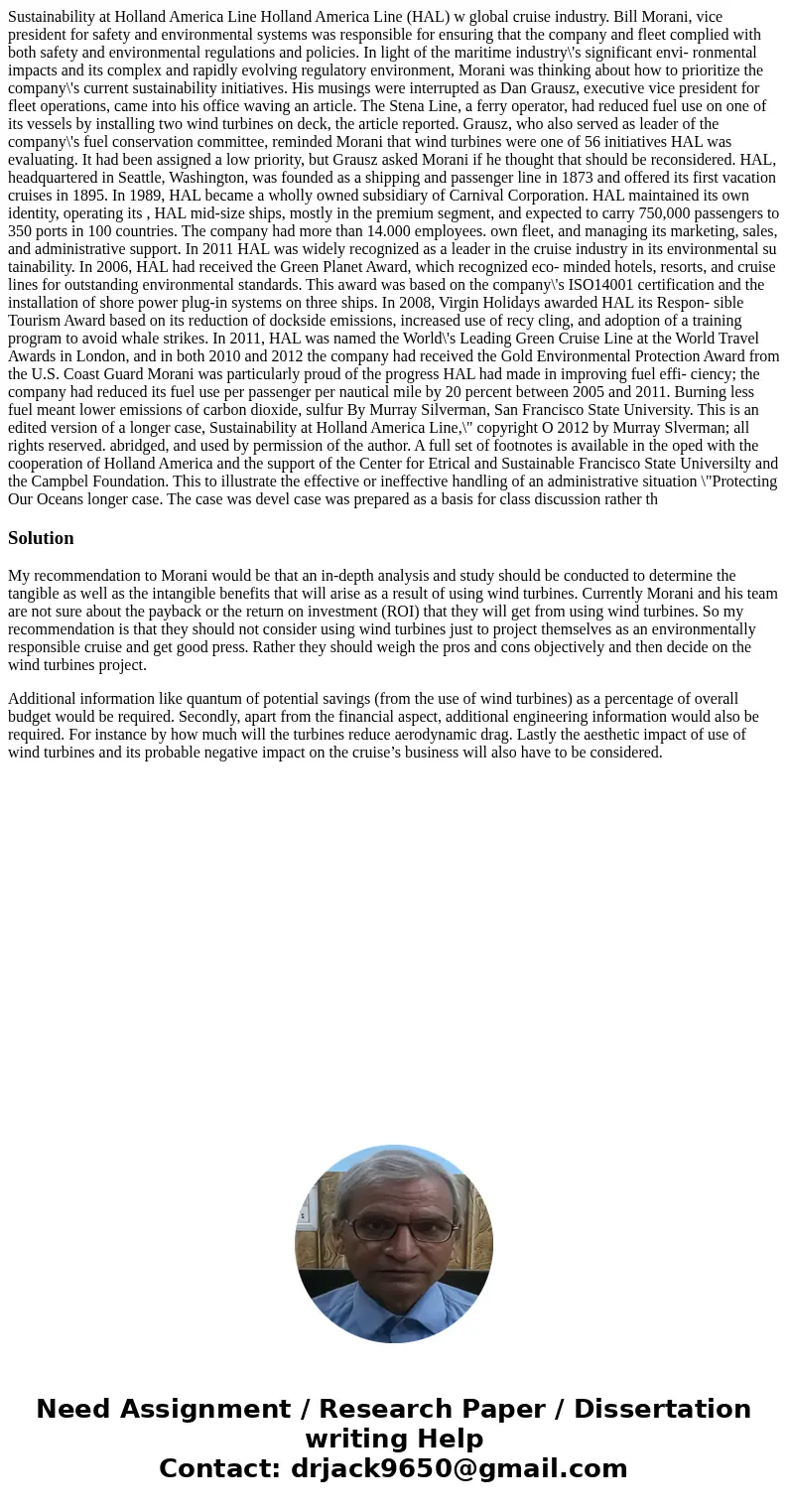Sustainability at Holland America Line Holland America Line (HAL) w global cruise industry. Bill Morani, vice president for safety and environmental systems was responsible for ensuring that the company and fleet complied with both safety and environmental regulations and policies. In light of the maritime industry\'s significant envi- ronmental impacts and its complex and rapidly evolving regulatory environment, Morani was thinking about how to prioritize the company\'s current sustainability initiatives. His musings were interrupted as Dan Grausz, executive vice president for fleet operations, came into his office waving an article. The Stena Line, a ferry operator, had reduced fuel use on one of its vessels by installing two wind turbines on deck, the article reported. Grausz, who also served as leader of the company\'s fuel conservation committee, reminded Morani that wind turbines were one of 56 initiatives HAL was evaluating. It had been assigned a low priority, but Grausz asked Morani if he thought that should be reconsidered. HAL, headquartered in Seattle, Washington, was founded as a shipping and passenger line in 1873 and offered its first vacation cruises in 1895. In 1989, HAL became a wholly owned subsidiary of Carnival Corporation. HAL maintained its own identity, operating its , HAL mid-size ships, mostly in the premium segment, and expected to carry 750,000 passengers to 350 ports in 100 countries. The company had more than 14.000 employees. own fleet, and managing its marketing, sales, and administrative support. In 2011 HAL was widely recognized as a leader in the cruise industry in its environmental su tainability. In 2006, HAL had received the Green Planet Award, which recognized eco- minded hotels, resorts, and cruise lines for outstanding environmental standards. This award was based on the company\'s ISO14001 certification and the installation of shore power plug-in systems on three ships. In 2008, Virgin Holidays awarded HAL its Respon- sible Tourism Award based on its reduction of dockside emissions, increased use of recy cling, and adoption of a training program to avoid whale strikes. In 2011, HAL was named the World\'s Leading Green Cruise Line at the World Travel Awards in London, and in both 2010 and 2012 the company had received the Gold Environmental Protection Award from the U.S. Coast Guard Morani was particularly proud of the progress HAL had made in improving fuel effi- ciency; the company had reduced its fuel use per passenger per nautical mile by 20 percent between 2005 and 2011. Burning less fuel meant lower emissions of carbon dioxide, sulfur By Murray Silverman, San Francisco State University. This is an edited version of a longer case, Sustainability at Holland America Line,\" copyright O 2012 by Murray Slverman; all rights reserved. abridged, and used by permission of the author. A full set of footnotes is available in the oped with the cooperation of Holland America and the support of the Center for Etrical and Sustainable Francisco State Universilty and the Campbel Foundation. This to illustrate the effective or ineffective handling of an administrative situation \"Protecting Our Oceans longer case. The case was devel case was prepared as a basis for class discussion rather th
My recommendation to Morani would be that an in-depth analysis and study should be conducted to determine the tangible as well as the intangible benefits that will arise as a result of using wind turbines. Currently Morani and his team are not sure about the payback or the return on investment (ROI) that they will get from using wind turbines. So my recommendation is that they should not consider using wind turbines just to project themselves as an environmentally responsible cruise and get good press. Rather they should weigh the pros and cons objectively and then decide on the wind turbines project.
Additional information like quantum of potential savings (from the use of wind turbines) as a percentage of overall budget would be required. Secondly, apart from the financial aspect, additional engineering information would also be required. For instance by how much will the turbines reduce aerodynamic drag. Lastly the aesthetic impact of use of wind turbines and its probable negative impact on the cruise’s business will also have to be considered.

 Homework Sourse
Homework Sourse